
Close-quarters battle (CQB), also called close-quarters combat (CQC), is a close combat situation between multiple combatants involving ranged or melee combat. It can occur between military units, law enforcement and criminal elements, and in other similar situations. CQB is typically defined as a short duration, high intensity conflict characterized by sudden violence at close range.
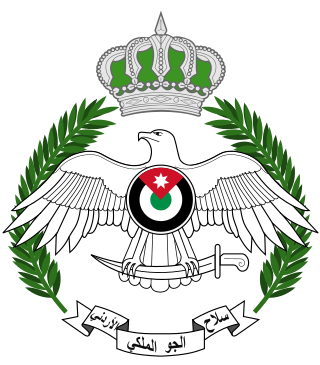
The Royal Jordanian Air Force is the aerial warfare branch of the Jordanian Armed Forces. Founded in 1955, the RJAF serves as the primary air defense organization in Jordan, with the mission of defending the nation’s airspace, providing ground support, and contributing to the broader national security strategy. Its role has expanded over the years from purely defensive operations to include Peacekeeping, humanitarian support, and active participation in regional coalitions.

The United States Army Special Operations Command (Airborne) (USASOC ( YOO-sə-sok)) is the command charged with overseeing the various special operations forces of the United States Army. Headquartered at Fort Liberty, North Carolina, it is the largest component of the United States Special Operations Command. It is an Army Service Component Command. Its mission is to organize, train, educate, man, equip, fund, administer, mobilize, deploy and sustain Army special operations forces to successfully conduct worldwide special operations.

Force Reconnaissance (FORECON) are United States Marine Corps deep reconnaissance companies that provide military intelligence to the command element of the Marine Air-Ground Task Force (MAGTF). Force Reconnaissance companies report to the Marine expeditionary force (MEF) and provide direct action and deep reconnaissance during large-scale operations.

Joint Expeditionary Base–Little Creek (JEB–LC), formerly known as Naval Amphibious Base Little Creek and commonly called simply Little Creek, is the major operating base for the Amphibious Forces in the United States Navy's Atlantic Fleet. The mission of the Naval Amphibious Base is to provide required support services to over 15,000 personnel of the 27 homeported ships and 78 resident and/or supported activities. The base's combination of operational, support, and training facilities are geared predominantly to amphibious operations, making the base unique among bases of the United States and Allied Navies.

The FV4030/4 Challenger 1 is a British main battle tank (MBT) used by the British Army from 1983 to 2001, when it was superseded by the Challenger 2. The majority of the Challenger 1 fleet was subsequently sold to Jordan where it remained in service with the Royal Jordanian Army until withdrawals were announced in 2018. Known locally as Al-Hussein, these vehicles received various Jordanian modifications before being replaced by French-made Leclerc tanks from the UAE and ex-Italian B1 Centauro 8x8 wheeled tank destroyers. The Jordanian Challenger 1 fleet had been retired by January 2023.

King Abdullah II Special Forces Group, commonly known as the JORSOF are strategic-level special forces of the Royal Jordanian Army under the Jordanian Armed Forces (JAF). Founded on April 15, 1963, on the orders of King Hussein, its primary roles include reconnaissance, counter-terrorism, search and evacuation, intelligence gathering combat, and the protection of key sites. The Special Forces Group are also charged with carrying out precision strikes against critical enemy targets. The unit is equipped and trained to be able to operate behind enemy lines for long periods without any logistical support and is considered some of the best in the Middle East.

Naval Surface Warfare Center Crane Division is the principal tenant command located at Naval Support Activity Crane in Indiana.

The Royal Jordanian Army is the ground force branch of the Jordanian Armed Forces (JAF). It draws its origins from units such as the Arab Legion, formed in the British Mandate of Transjordan in the 1920s. It has seen combat against Israel in 1948, 1956, 1967, and 1973. The Army also fought the Syrians and the PLO during Black September in 1970.

Operations Specialist is a United States Navy and United States Coast Guard occupational rating. It is a sea duty-intensive rating in the Navy while most of Coast Guard OS's are at ashore Command Centers.
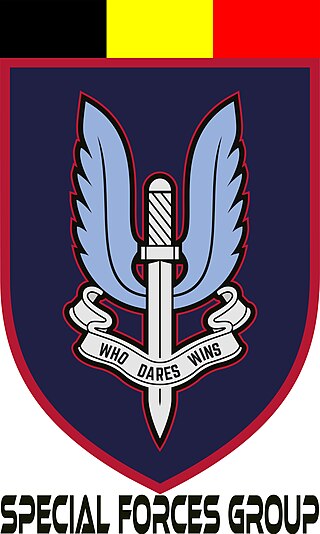
The Special Forces Group is the special forces unit in the Land Component of the Belgian Armed Forces.
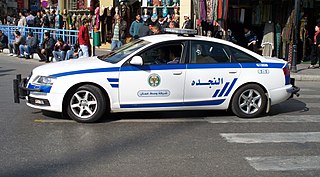
Law enforcement in Jordan is the purview of the "Public Security Force", the Jordanian national police, which is subordinate to the Public Security Directorate of the Ministry of Interior.

The Special Forces Qualification Course (SFQC) or, informally, the Q Course is the initial formal training program for entry into the United States Army Special Forces. Phase I of the Q Course is Special Forces Assessment and Selection (SFAS). A candidate who is selected at the conclusion of SFAS will enable a candidate to continue to the next of the four phases. If a candidate successfully completes all phases they will graduate as a Special Forces qualified soldier and then, generally, be assigned to a 12-men Operational Detachment "A" (ODA), commonly known as an "A team." The length of the Q Course changes depending on the applicant's primary job field within Special Forces and their assigned foreign language capability but will usually last between 56 and 95 weeks.
The ADMS is an emergency and disaster management training simulation system designed to train incident commanders, first responders, and incident command teams in a real-time, interactive virtual reality environment. ADMS was first introduced by Environmental Tectonics Corporation (ETCC:US) in 1992. The development of ADMS was in response to the crash of British Airtours Flight 28M at the Manchester airport in 1985, in which 55 people died. Following the accident research indicated that first responder training should include realistic scenarios. The first ADMS system was produced for the UK Ministry of Defence, and delivered to Royal Air Force's (RAF) Manston Facility. Since its inception, ADMS has evolved into a modular, expandable disaster simulation platform, with systems in use worldwide.
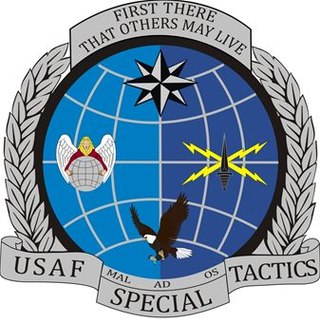
A United States Air Force Special Tactics Officer is a United States Air Force Special Operations Command (AFSOC) Special Warfare Officer who manages the training and equipping of U.S. Air Force ground special operations. Special Tactics Officers deploy as team leaders or mission commanders in combat, seizing and controlling airstrips, combat search and rescue, guiding airstrikes and fire support using air assets for special operations and tactical weather observations and forecasting. Special Tactics Officers are not Pararescuemen, Combat Controllers, or Special Reconnaissance, but they lead the Special Tactics Squadrons and Groups and thoroughly understand how to conduct, manage, and provide these special operations missions to both conventional and joint special operations missions needed within Joint Special Operations Command (JSOC) and United States Special Operations Command (SOCOM).

The Annual Warrior Competition is a combat-oriented competition that pits special operations military and police teams against each other. Teams are assessed in events testing physical fitness, marksmanship drills, medical tasks and written exams. The competition takes place at the King Abdullah II Special Operations Training Centre (KASOTC) in Amman, Jordan. Jordan created the competition in May 2009.

The Royal Tank Museum is a military museum in Amman, Jordan, was inaugurated on January 29, 2018. Located next to the King Abdullah II Park in Al Muqabalain. The Royal Tank Museum spans an area of approximately 20,000 square meters and houses around 110 tanks and armored vehicles from Jordan, Arab nations, and foreign countries, displayed in chronological order. The collection includes a number of American, British, Soviet, and German-made vehicles, with a dedicated hall showcasing local military industries. The museum features both original and restored rare items, illustrating the historical evolution of military vehicles since 1915. The museum's design was created by Jordanian architect Zaid Dawood.

Rapid reaction forces are brigade-strength forces with high combat readiness, immediate response speed, flexible and highly mobile that are able to operate independently, within Jordanian forces, or with friendly and allied forces to defend Jordanian national security within the borders of the Kingdom of Jordan or Outside in all circumstances at the time and place and in accordance with the orders of the General Command of the Armed Forces.
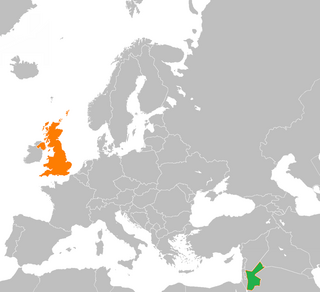
Jordan–United Kingdom relations, or Anglo-Jordanian relations, refers to the relationship between the Hashemite Kingdom of Jordan and the United Kingdom of Great Britain and Northern Ireland.
The 104th Operational Maneuvers Regiment is a special forces regiment of the Algerian Land Forces, and is also a parachute regiment.





















